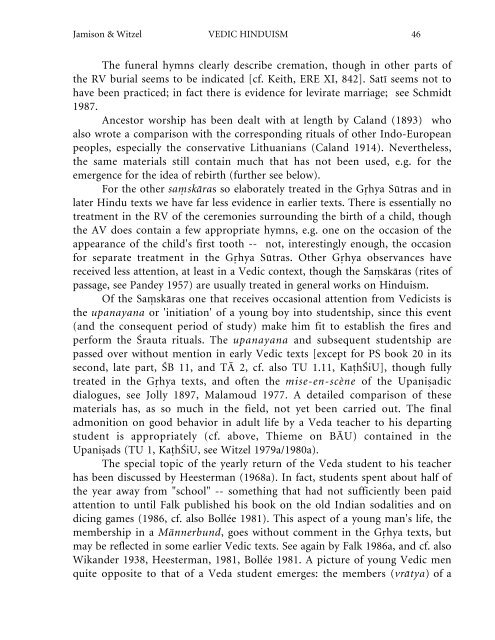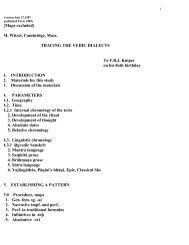VEDIC HINDUISM by S. W. Jamison and M. Witzel - people.fas ...
VEDIC HINDUISM by S. W. Jamison and M. Witzel - people.fas ...
VEDIC HINDUISM by S. W. Jamison and M. Witzel - people.fas ...
You also want an ePaper? Increase the reach of your titles
YUMPU automatically turns print PDFs into web optimized ePapers that Google loves.
<strong>Jamison</strong> & <strong>Witzel</strong> <strong>VEDIC</strong> <strong>HINDUISM</strong> 46<br />
The funeral hymns clearly describe cremation, though in other parts of<br />
the RV burial seems to be indicated [cf. Keith, ERE XI, 842]. Satī seems not to<br />
have been practiced; in fact there is evidence for levirate marriage; see Schmidt<br />
1987.<br />
Ancestor worship has been dealt with at length <strong>by</strong> Cal<strong>and</strong> (1893) who<br />
also wrote a comparison with the corresponding rituals of other Indo-European<br />
<strong>people</strong>s, especially the conservative Lithuanians (Cal<strong>and</strong> 1914). Nevertheless,<br />
the same materials still contain much that has not been used, e.g. for the<br />
emergence for the idea of rebirth (further see below).<br />
For the other sa�skåras so elaborately treated in the G�hya Sūtras <strong>and</strong> in<br />
later Hindu texts we have far less evidence in earlier texts. There is essentially no<br />
treatment in the RV of the ceremonies surrounding the birth of a child, though<br />
the AV does contain a few appropriate hymns, e.g. one on the occasion of the<br />
appearance of the child's first tooth -- not, interestingly enough, the occasion<br />
for separate treatment in the G�hya Sūtras. Other G�hya observances have<br />
received less attention, at least in a Vedic context, though the Sa�skåras (rites of<br />
passage, see P<strong>and</strong>ey 1957) are usually treated in general works on Hinduism.<br />
Of the Sa�skåras one that receives occasional attention from Vedicists is<br />
the upanayana or 'initiation' of a young boy into studentship, since this event<br />
(<strong>and</strong> the consequent period of study) make him fit to establish the fires <strong>and</strong><br />
perform the Śrauta rituals. The upanayana <strong>and</strong> subsequent studentship are<br />
passed over without mention in early Vedic texts [except for PS book 20 in its<br />
second, late part, ŚB 11, <strong>and</strong> TĀ 2, cf. also TU 1.11, Ka�hŚiU], though fully<br />
treated in the G�hya texts, <strong>and</strong> often the mise-en-scène of the Upani�adic<br />
dialogues, see Jolly 1897, Malamoud 1977. A detailed comparison of these<br />
materials has, as so much in the field, not yet been carried out. The final<br />
admonition on good behavior in adult life <strong>by</strong> a Veda teacher to his departing<br />
student is appropriately (cf. above, Thieme on BĀU) contained in the<br />
Upani�ads (TU 1, Ka�hŚiU, see <strong>Witzel</strong> 1979a/1980a).<br />
The special topic of the yearly return of the Veda student to his teacher<br />
has been discussed <strong>by</strong> Heesterman (1968a). In fact, students spent about half of<br />
the year away from "school" -- something that had not sufficiently been paid<br />
attention to until Falk published his book on the old Indian sodalities <strong>and</strong> on<br />
dicing games (1986, cf. also Bollée 1981). This aspect of a young man's life, the<br />
membership in a Männerbund, goes without comment in the G�hya texts, but<br />
may be reflected in some earlier Vedic texts. See again <strong>by</strong> Falk 1986a, <strong>and</strong> cf. also<br />
Wik<strong>and</strong>er 1938, Heesterman, 1981, Bollée 1981. A picture of young Vedic men<br />
quite opposite to that of a Veda student emerges: the members (vråtya) of a

















